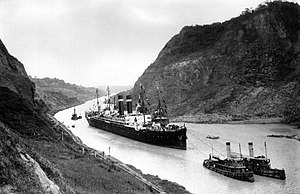
APL, formerly called American President Lines Ltd., is an American container shipping company that is a subsidiary of French shipping company CMA CGM. It operates an all-container ship fleet, including nine U.S. flagged container vessels.
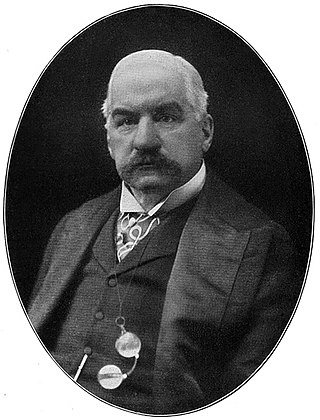
The International Mercantile Marine Company, originally the International Navigation Company, was a trust formed in the early twentieth century as an attempt by J.P. Morgan to monopolize the shipping trade.

The Pacific Mail Steamship Company was founded April 18, 1848, as a joint stock company under the laws of the State of New York by a group of New York City merchants. Incorporators included William H. Aspinwall, Edwin Bartlett, Henry Chauncey, Mr. Alsop, G.G. Howland and S.S. Howland.

The American Line was a shipping company founded in 1871 and based in Philadelphia, Pennsylvania. It began as part of the Pennsylvania Railroad, although the railroad got out of the shipping business soon after founding the company. In 1902, it became part of the International Navigation Co., with the American Line generally handling traffic between the United States ports of Philadelphia and New York City and the British ports of Liverpool and Southampton. Sister company Red Star Line handled traffic between America and the European continent, primarily through Antwerp, Belgium. The company's most prominent president was Clement Griscom, who led the company from 1888 to 1902 and worked as a company executive for its entire existence. During its existence, the company was the largest American shipping company, rivalled only by the smaller, Baltimore-based Atlantic Transport Lines, although this distinction is a marginal one, as all American oceanic shipping concerns were dwarfed by British companies such as the White Star Line or Cunard Line and German ones such as HAPAG.

SS Mongolia was a 13,369-ton passenger-and-cargo liner originally built for Pacific Mail Steamship Company in 1904. She later sailed as USS Mongolia (ID-1615) for the U.S. Navy, as SS President Fillmore for the Dollar Line and as SS Panamanian for Cia Transatlantica Centroamericano.

SS Argentina was a US turbo-electric ocean liner. She was completed in 1929 as SS Pennsylvania, and refitted and renamed as SS Argentina in 1938. From 1942 to 1946 she was the War Shipping Administration operated troopship Argentina. She was laid up in 1958 and scrapped in 1964.
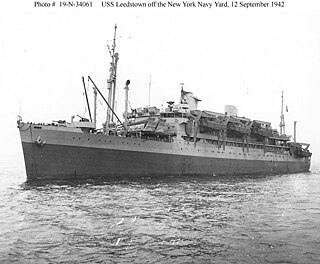
USS Leedstown (AP-73), built as the Grace Line passenger and cargo ocean liner SS Santa Lucia, served as a United States Navy amphibious assault ship in World War II. The ship had first been turned over to the War Shipping Administration (WSA) and operated by Grace Line as the WSA agent from February to August 1942 in the Pacific. In August the ship, at New York, was turned over to the Navy under sub-bareboat charter from WSA. She was sunk 9 November 1942 off the Algerian coast by a German submarine after German bombers caused damage the day before.

SS California was the World's first major ocean liner built with turbo-electric propulsion. When launched in 1927 she was also the largest merchant ship yet built in the US, although she was a modest size compared with the biggest European liners of her era.
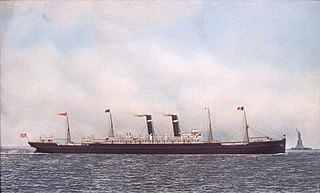
SS Finland was an American-flagged ocean liner built in 1902 for the Red Star Line. During World War I she served as a transport for the United States Navy named USS Finland (ID-4543). Before her Navy service in 1917, she was also USAT Finland for the United States Army.

SS Kroonland was an ocean liner for International Mercantile Marine (IMM) from her launch in 1902 until she was scrapped in 1927. Kroonland was the sister ship of Finland and a near sister ship of Vaderland and Zeeland of the same company. Kroonland sailed for IMM's Red Star Line for 15 years, and also sailed for IMM's American Line and Panama Pacific Line. During World War I, the ship served as United States Army transport USAT Kroonland through April 1918, and as the Navy auxiliary USS Kroonland (ID-1541) from April 1918 to October 1919.

SS La Touraine was an ocean liner that sailed for the Compagnie Générale Transatlantique from the 1890s to the 1920s. Built in France in 1891, she was primarily employed in transatlantic service on the North Atlantic. The liner was scrapped in Dunkirk in October 1923.

SS Zeeland was a British and Belgian ocean liner of the International Mercantile Marine Co. (IMM). She was a sister ship to Vaderland and a near sister ship to Kroonland and Finland of the same company. Although her name was Dutch, it was changed during World War I to the less German-sounding SS Northland. She served for a time as a British troop ship under the name HMT Northland. Reverting to Zeeland after the war, the ship was renamed SS Minnesota late in her career. Zeeland sailed primarily for IMM's Red Star Line for most of her early career, but also sailed under charter for the White Star Line, the International Navigation Company, the American Line, and the Atlantic Transport Line, all IMM subsidiary lines. The pursers safe survived the scrapyard at Inverkeithing and after residing in a wardrobe for 80 years is currently on display in a local private home.

SS Manchuria was a passenger and cargo liner launched 1903 for the San Francisco-trans Pacific service of the Pacific Mail Steamship Company. During World War I the ship was commissioned 25 April 1918–11 September 1919 for United States Navy service as USS Manchuria (ID-1633). After return to civilian service the ship was acquired by the Dollar Steamship Line in 1928 until that line suffered financial difficulties in 1938 and ownership of Manchuria was taken over by the United States Maritime Commission which chartered the ship to American President Lines which operated her as President Johnson. During World War II she operated as a War Shipping Administration transport with American President Lines its agent allocated to United States Army requirements. After World War II, she was returned to American President Lines, sold and renamed Santa Cruz. The liner was scrapped in Italy in 1952.

SS Iowan was a cargo ship built in 1914 for the American-Hawaiian Steamship Company. During World War I she was taken over by the United States Navy and commissioned as USS Iowan (ID-3002). During World War II, the ship was transferred to the Soviet Union and renamed SS Tashkent.
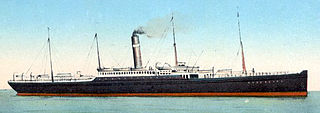
SS Merion was an ocean liner built in 1902 for the American Line, a subsidiary line of the International Mercantile Marine (IMM). She also sailed for the Red Star Line and the Dominion Line—both subsidiary lines of IMM—during her passenger career. After the outbreak of World War I she was bought by the British Admiralty and converted to serve as a decoy resembling the Royal Navy battlecruiser HMS Tiger. In May 1915, while posing as Tiger in the Aegean Sea, Merion was sunk by the German submarine SM UB-8.

CSAV is a Chilean shipping company that is currently the largest company of its type in Latin America and also one of the oldest ones, having been founded in 1872.

The first Saxonia was a passenger ship of the British Cunard Line. Between 1900 and 1925, Saxonia operated on North Atlantic and Mediterranean passenger routes, and she saw military service during World War I (1914–1918).

SS Brazil was a US turbo-electric ocean liner. She was completed in 1928 as Virginia, and refitted and renamed Brazil in 1938. From 1942 to 1946 she was the War Shipping Administration operated troopship Brazil. She was laid up in 1958 and scrapped in 1964.

SS Sierra Cordoba was a Norddeutscher Lloyd passenger and cargo ship completed 1913 by AG Vulcan Stettin. The ship operated between Bremen and Buenos Aires on the line's South American service and was equipped with wireless and "submarine sounding apparatus" with accommodations for 116 first class, 74 second class and 1,270 "between decks" passengers. A description after the ship had been seized and restored in 1919 noted she was among the fastest and best equipped ships of the line with accommodations for 115 first class passengers and 1,572 third and steerage class passengers as well as a crew of 179 officers and men.

Corvus was a steam cargo ship built in 1919 by Columbia River Shipbuilding Company of Portland for the United States Shipping Board as part of the wartime shipbuilding program of the Emergency Fleet Corporation (EFC) to restore the nation's Merchant Marine. The freighter was operated on international and domestic routes through 1944. Early in 1945 she was transferred to Soviet Union as part of lend-lease program and renamed Uzbekistan. After several months of operation, the freighter was rammed by another vessel on 31 May 1945 and was beached to avoid sinking. She was subsequently raised and towed to Portland where she was scrapped in 1946.
